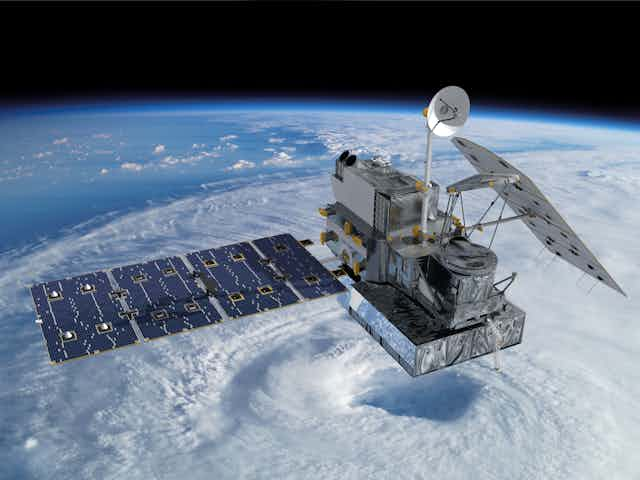This is an article from Curious Kids, a series for children. The Conversation is asking kids to send in questions they’d like an expert to answer. All questions are welcome – serious, weird or wacky!
How do satellites get back to Earth?– Charlie Crittenden, age 7, Coledale.
The short answer is that most satellites don’t come back to Earth at all. Most of them burn to a crisp before they get anywhere near the ground.
Every day, bits of space junk get burnt up in the sky above our heads. Most of the time we don’t even notice.
Satellites are always falling towards the Earth, but never reaching it - that’s how they stay in orbit. They are meant to stay there, and usually there is no plan to bring them back to Earth. From orbit, they send us pictures of the Earth and signals to help us find our way about.
Read more: Curious Kids: Why is the sky blue and where does it start?
Those closest to the Earth will eventually fall into the atmosphere and burn up (atmosphere means the breathable air that surrounds our planet). This is a good thing, because we don’t want old satellites staying up there as junk. Some fall back within weeks of being launched. Others are up there for hundreds of years.
Mostly, their orbits are above the thickest parts of the atmosphere. But eventually, the heat of the Sun makes them fall into Earth’s atmosphere. I’ll explain how.
Roaring into the atmosphere
Satellites don’t move in circles. Their orbits are oval-shaped, which means that sometimes a satellite will be closer to the Earth than other times.
The Sun heats the atmosphere during the day and when it’s more active. When the gases in the atmosphere are heated, they grow outwards and surround the satellites when they are nearest to the Earth. The particles rub against the satellite (scientists call this friction) and slow it down, dragging it a little lower. Over time, the satellite reaches the upper layers of atmosphere.
But when I say “reaches”, it’s actually very quick. The satellite roars into the atmosphere at high speed - as much as 28,000km per hour. That’s about 35 times faster than a plane!
Read more: Space bling: 'jewelled' LAGEOS satellites help us to measure the Earth
And because the friction is even higher than before, it heats up. This is like rubbing sticks together to make fire. The heat makes the satellite break into pieces.
Only some pieces survive to fall onto the surface of the Earth, or into the sea. These are often steel fuel tanks or titanium spheres - also called space balls. Sometimes, people find them on the ground many years later.
A few satellites, like China’s Shijian-10, are designed to return to Earth, because they have collected samples that scientists want to study. These satellites have heat shields to keep them cool and parachutes to slow them down so that they land softly, still in one piece.
Hello, curious kids! Have you got a question you’d like an expert to answer? Ask an adult to send your question to us. They can:
* Email your question to curiouskids@theconversation.edu.au
* Tell us on Twitter by tagging @ConversationEDU with the hashtag #curiouskids, or
* Tell us on Facebook

Please tell us your name, age, and which city you live in. You can send an audio recording of your question too, if you want. Send as many questions as you like! We won’t be able to answer every question but we will do our best.

